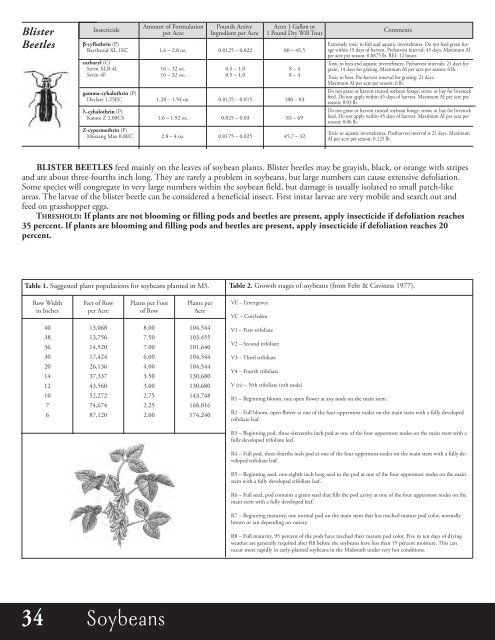Agronomic Crops
mJyPrJ
mJyPrJ
You also want an ePaper? Increase the reach of your titles
YUMPU automatically turns print PDFs into web optimized ePapers that Google loves.
Blister<br />
Beetles<br />
Insecticide<br />
b-cyfluthrin (P)<br />
Baythroid XL 1EC<br />
carbaryl (C)<br />
Sevin XLR 4L<br />
Sevin 4F<br />
gamma-cyhalothrin (P)<br />
Declare 1.25EC<br />
λ-cyhalothrin (P)<br />
Karate Z 2.08CS<br />
Z-cypermethrin (P)<br />
Mustang Max 0.8EC<br />
Amount of Formulation<br />
per Acre<br />
1.6 – 2.8 oz.<br />
16 – 32 oz.<br />
16 – 32 oz.<br />
1.28 – 1.54 oz.<br />
1.6 – 1.92 oz.<br />
2.8 – 4 oz.<br />
Pounds Active<br />
Ingredient per Acre<br />
0.0125 – 0.022<br />
0.5 – 1.0<br />
0.5 – 1.0<br />
0.0125 – 0.015<br />
0.025 – 0.03<br />
0.0175 – 0.025<br />
Acres 1 Gallon or<br />
1 Pound Dry Will Treat<br />
80 – 45.5<br />
8 – 4<br />
8 – 4<br />
100 – 83<br />
83 – 69<br />
45.7 – 32<br />
Comments<br />
Extremely toxic to fish and aquatic invertebrates. Do not feed green forage<br />
within 15 days of harvest. Preharvest interval: 45 days. Maximum AI<br />
per acre per season: 0.0875 lb. REI: 12 hours.<br />
Toxic to bees and aquatic invertebrates. Preharvest intervals: 21 days for<br />
grain, 14 days for grazing. Maximum AI per acre per season: 6 lb.<br />
Toxic to bees. Pre-harvest interval for grazing: 21 days.<br />
Maximum AI per acre per season: 6 lb.<br />
Do not graze or harvest treated soybean forage, straw, or hay for livestock<br />
feed. Do not apply within 45 days of harvest. Maximum AI per acre per<br />
season: 0.03 lb.<br />
Do not graze or harvest treated soybean forage, straw, or hay for livestock<br />
feed. Do not apply within 45 days of harvest. Maximum AI per acre per<br />
season: 0.06 lb.<br />
Toxic to aquatic invertebrates. Postharvest interval is 21 days. Maximum<br />
AI per acre per season: 0.125 lb.<br />
BLIsteR BeetLes feed mainly on the leaves of soybean plants. Blister beetles may be grayish, black, or orange with stripes<br />
and are about three-fourths inch long. They are rarely a problem in soybeans, but large numbers can cause extensive defoliation.<br />
Some species will congregate in very large numbers within the soybean field, but damage is usually isolated to small patch-like<br />
areas. The larvae of the blister beetle can be considered a beneficial insect. First instar larvae are very mobile and search out and<br />
feed on grasshopper eggs.<br />
tHResHoLD: If plants are not blooming or filling pods and beetles are present, apply insecticide if defoliation reaches<br />
35 percent. If plants are blooming and filling pods and beetles are present, apply insecticide if defoliation reaches 20<br />
percent.<br />
table 1. Suggested plant populations for soybeans planted in MS. table 2. Growth stages of soybeans (from Fehr & Caviness 1977).<br />
Row Width<br />
in Inches<br />
Feet of Row<br />
per Acre<br />
Plants per Foot<br />
of Row<br />
Plants per<br />
Acre<br />
VE – Emergence<br />
VC – Cotyledon<br />
40<br />
38<br />
36<br />
30<br />
20<br />
14<br />
12<br />
10<br />
7<br />
6<br />
13,068<br />
13,756<br />
14,520<br />
17,424<br />
26,136<br />
37,337<br />
43,560<br />
52,272<br />
74,674<br />
87,120<br />
8.00<br />
7.50<br />
7.00<br />
6.00<br />
4.00<br />
3.50<br />
3.00<br />
2.75<br />
2.25<br />
2.00<br />
104,544<br />
103,455<br />
101,640<br />
104,544<br />
104,544<br />
130,680<br />
130,680<br />
143,748<br />
168,016<br />
174,240<br />
V1 – First trifoliate<br />
V2 – Second trifoliate<br />
V3 – Third trifoliate<br />
V4 – Fourth trifoliate<br />
V (n) – Nth trifoliate (nth node)<br />
R1 – Beginning bloom, one open flower at any node on the main stem.<br />
R2 – Full bloom, open flower at one of the four uppermost nodes on the main stem with a fully developed<br />
trifoliate leaf.<br />
R3 – Beginning pod, three-sixteenths inch pod at one of the four uppermost nodes on the main stem with a<br />
fully developed trifoliate leaf.<br />
R4 – Full pod, three-fourths inch pod at one of the four uppermost nodes on the main stem with a fully developed<br />
trifoliate leaf.<br />
R5 – Beginning seed, one-eighth inch long seed in the pod at one of the four uppermost nodes on the main<br />
stem with a fully developed trifoliate leaf.<br />
R6 – Full seed, pod contains a green seed that fills the pod cavity at one of the four uppermost nodes on the<br />
main stem with a fully developed leaf.<br />
R7 – Beginning maturity, one normal pod on the main stem that has reached mature pod color, normally<br />
brown or tan depending on variety.<br />
R8 – Full maturity, 95 percent of the pods have reached their mature pod color. Five to ten days of drying<br />
weather are generally required after R8 before the soybeans have less than 15 percent moisture. This can<br />
occur more rapidly in early-planted soybeans in the Midsouth under very hot conditions.<br />
34 Soybeans


